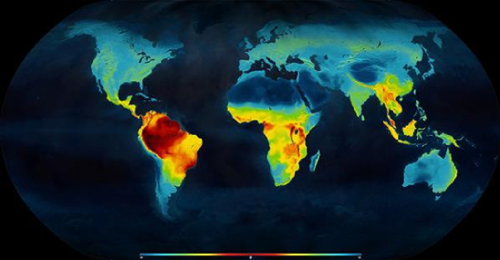Biodiversity
 From Wikiversity - Reading time: 4 min
From Wikiversity - Reading time: 4 min

Biodiversity is the total of all the genetic variation contained within the biosphere (living world).
Biodiversity may be considered locally or globally. Local biodiversity can cover any amount of space. Examples of local biodiversity would be the number of species found in a local park, in a city, or on a continent. Global biodiversity covers the entire world.
Biodiversity is measured in four main ways:
- taxonomic diversity (usually measured at the species diversity level)
- ecological diversity often viewed from the perspective of ecosystem diversity
- morphological diversity which stems from genetic diversity and molecular diversity
- functional diversity which is a measure of the number of functionally disparate species within a population (e.g. different feeding mechanism, different motility, predator vs prey, etc.)
(see Introduction for references)
Learning Tasks
[edit | edit source]- (Distribution) Look on the distribution of biodiversity on the global map. Biodiversity is not evenly distributed on global map. Could you identify factors that can serve as indicators for the diversity in specific regions and identify causes for loss of biodiversity on the globe. Start from the consideration, that diversity of all living things (biota) depends on temperature, precipitation, altitude, soils, geography and the presence of other species living in symbiosis or due to dependencies in a food chain. The study of the spatial distribution of organisms, species and ecosystems, is the science of biogeography.[1][2].
- What are human factors that have an impact on the distribution of biodiversity?
- Assume you get environmental conditions as information for a specific area on the globe and/or the geolocation of the area and/or the populations density and/or pollution. What are the most important factor estimate biodiversity in specific region?
- Consider climate change scenarios and estimate the impact on biodiversity due to changes in the environmental conditions. Search for scientific evidence in peer-reviewed journals about the link between biodiversity and climate change.
Comments Distribution of Biodiversity
[edit | edit source]Diversity consistently measures higher in the tropics and in other localized regions such as the Cape Floristic Region and lower in polar regions generally. Rain forests that have had wet climates for a long time, such as Yasuní National Park in Ecuador, have particularly high biodiversity.[3][4]
Terrestrial biodiversity is thought to be up to 25 times greater than ocean biodiversity.[5] Forests harbour most of Earth's terrestrial biodiversity. The conservation of the world's biodiversity is thus utterly dependent on the way in which we interact with and use the world's forests.[6] A new method used in 2011, put the total number of species on Earth at 8.7 million, of which 2.1 million were estimated to live in the ocean.[7] However, this estimate seems to under-represent the diversity of microorganisms.[8] Forests provide habitats for 80 percent of amphibian species, 75 percent of bird species and 68 percent of mammal species. About 60 percent of all vascular plants are found in tropical forests. Mangroves provide breeding grounds and nurseries for numerous species of fish and shellfish and help trap sediments that might otherwise adversely affect seagrass beds and coral reefs, which are habitats for many more marine species.[9]
Learning Resources
[edit | edit source]See also
[edit | edit source]References
[edit | edit source]- ↑ Morand, Serge; Krasnov, Boris R. (1 September 2010). The Biogeography of Host-Parasite Interactions. Oxford University Press. pp. 93–94. ISBN 978-0-19-956135-3. Retrieved 28 June 2011.
- ↑ Cardinale, Bradley. J.; et al. (March 2011). "The functional role of producer diversity in ecosystems". American Journal of Botany. 98 (3): 572–592. doi:10.3732/ajb.1000364. hdl:2027.42/141994. PMID 21613148.
- ↑ "A Durable Yet Vulnerable Eden in Amazonia". Dot Earth blog, New York Times. 20 January 2010. Retrieved 2 February 2013.
- ↑ Margot S. Bass; Matt Finer; Clinton N. Jenkins; Holger Kreft; Diego F. Cisneros-Heredia; Shawn F. McCracken; Nigel C. A. Pitman; Peter H. English et al. (2010). "Global Conservation Significance of Ecuador's Yasuní National Park". PLOS ONE 5 (1): e8767. doi:10.1371/journal.pone.0008767. PMID 20098736. PMC 2808245. //www.ncbi.nlm.nih.gov/pmc/articles/PMC2808245/.
- ↑ Benton M. J. (2001). "Biodiversity on land and in the sea". Geological Journal 36 (3–4): 211–230. doi:10.1002/gj.877.
- ↑ The State of the World's Forests 2020. In brief - Forests, biodiversity and people. Rome, Italy: FAO & UNEP. 2020. doi:10.4060/ca8985en. ISBN 978-92-5-132707-4.
- ↑ Mora, C. (2011). "How Many Species Are There on Earth and in the Ocean?". PLOS Biology 9 (8): e1001127. doi:10.1371/journal.pbio.1001127. PMID 21886479. PMC 3160336. //www.ncbi.nlm.nih.gov/pmc/articles/PMC3160336/.
- ↑ Microorganisms Editorial Office (2019-01-09). "Acknowledgement to Reviewers of Microorganisms in 2018". Microorganisms 7 (1): 13. doi:10.3390/microorganisms7010013. PMC 6352028. //www.ncbi.nlm.nih.gov/pmc/articles/PMC6352028/.
- ↑ The State of the World's Forests 2020. In brief – Forests, biodiversity and people. Rome, Italy: FAO & UNEP. 2020. doi:10.4060/ca8985en. ISBN 978-92-5-132707-4.
Page Information
[edit | edit source]This page was based on the following wikipedia-source page:
 KSF
KSF